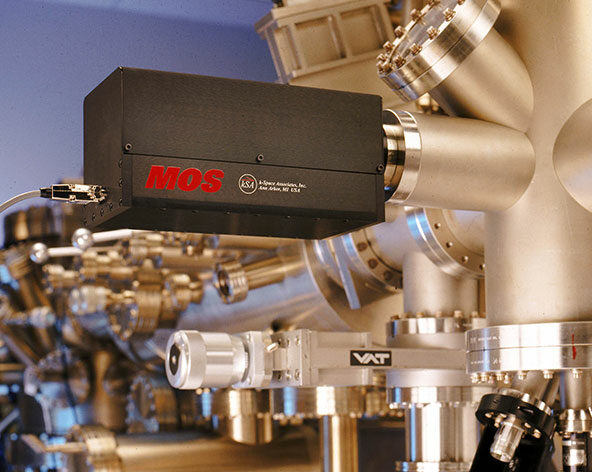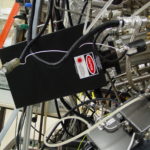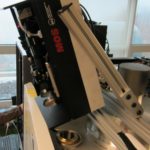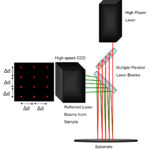Measure and provide feedback for curvature, stress, reflectivity and growth rate to improve production processes and increase profitability with the kSA MOS.
Understanding and controlling stress in thin-film and thermal annealing processes is critical for achieving the desired optical, electronic, and mechanical properties. Many of today’s high performance devices rely on or must be designed with “built-in” stress within the individual layers for tailoring specific characteristics. However, unwanted changes in thin-film stress can be introduced at any stage of the fabrication process and may lead to a reduction in device performance as well as delamination or cracking of deposited films.
Traditional ex situ stress/strain measurement methods such as XRD or surface profiling only measure the overall stress after the process is done, but completely miss the dynamic changes in thin-film stress occurring during the process. Being able to measure the stress/strain in situ, during the process gives important insight into mechanisms and methods for controlling and targeting the overall stress induced into the sample during every step.
Real-Time Thin-Film Curvature and Stress in Two Directions Simultaneously
In response to a need for in situ thin-film stress measurement, kSA co-developed and patented a new, real-time stress/strain monitoring technique with Sandia National Laboratory over 15 years ago. The k-Space Multi-beam Optical Sensor (kSA MOS) uses an etalon, with highly reflective dielectric coatings on each side, that is placed at an angle to a single solid state laser beam. The incidence angle of the laser leads to multiple internal reflections within the etalon, which generates a linear array of parallel beams. These beams also pass through a second rotated etalon to produce a 2-dimensional array of beams for simultaneous 2D measurements in both x and y planes. The number and spacing of these beams can be controlled by the rotation angle of each etalon. The low power (Class 1) array of parallel beams is then reflected from the sample surface and directly imaged with a high resolution camera. During thin-film or thermal stress, the sample being imaged with the kSA MOS laser array will undergo convex or concave changes in curvature which translate into the laser spots getting farther apart (convex) or closer (concave) relative to each other on the camera. By using this wafer curvature measurement and the known geometry and material properties of the substrate and film, real-time stress is determined directly via Stoney’s equation.
In Situ Measurement
The kSA MOS optics are mounted directly to the vacuum or process chamber viewport and contain laser-beam array optics and camera optics with patented automatic steering mirror to ensure the laser array stays directly on the camera center. Chamber integration can be with single port (normal incidence) or dual port (specular viewports) and provides several benefits for in situ thin-film stress measurement. The kSA MOS optics are simple and stationary, requiring only minimal alignment and calibration during initial setup. Simultaneous detection and spot spacing analysis of the array makes the measurement inherently less sensitive to sample vibration compared with scanning, single beam systems. Since all the kSA MOS laser spots move together at the same frequency, sample shift or tilt is not detected as a change of curvature. Through the use of simple image processing and rapid data analysis algorithms, kSA MOS technology can easily detect micron-size changes in spot position on the camera. This translates to radius of curvature resolution in the 20-50km range; powerful enough to detect the stress induced by a single monolayer of material deposited on the substrate surface. By monitoring the entire array of beams, two-dimensional, dynamic wafer and thin-film curvature and stress profiles can be obtained with enough speed necessary for real-time measurement and process control.
Applications
The kSA MOS thin-film measurement tool is currently being used for in situ stress monitoring and control at leading R&D and full production facilities worldwide. Applications include metal film sputtering, high performance dielectric and filter coatings (PVD), glass panel processing, 300mm semiconductor IC processing, thin-film battery research, epitaxial layer growth during MBE and MOCVD, and thermal stress monitoring during annealing. Don’t wait until it’s too late – control your thin-film or thermal stress in real time with kSA MOS!
References
View All ReferencesEffect of Crystallite Geometries on Electrochemical Performance of Porous Intercalation Electrodes by Multiscale Operando Investigation
Yuting Luo, Yang Bai, Aashutosh Mistry, Yuwei Zhang, Dexin Zhao, Susmita Sarkar, Joseph V. Handy, Shahed Rezaei, Andrew Chihpin Chuang, Luis Carrillo, Kamila Wiaderek, Matt Pharr, Kelvin Xie, Partha P. Mukherjee, Bai-Xiang Xu & Sarbajit Banerjee
Growth design for high quality AlxGa (1− x) N layer with high AlN-fraction on Si (1 1 1) substrate by MOCVD
Abheek Bardhan, Srinivasan Raghav
Reconfiguration of Amorphous Complex Oxides: A Route to a Broad Range of Assembly Phenomena, Hybrid Materials, and Novel Functionalities
Divya J. Prakash,Yajin Chen,Mengistie L. Debasu,Donald E. Savage,Chaiyapat Tangpatjaroen,Christoph Deneke,Angelo Malachias,Adam D. Alfieri,Omar Elleuch,Kaddour Lekhal,Izabela Szlufarska,Paul G. Evans,Francesca Cavallox
Wafer-Scale Electroactive Nanoporous Silicon: Large and Fully Reversible Electrochemo-Mechanical Actuation in Aqueous Electrolytes
Manuel Brinker and Patrick Huber
Silicon Contamination of the Praseodymium Doped Ceria Oxygen Surfaced Exchange Coefficient
Yuxi Ma and Jason D. Nicholas
Negative Thermal Expansion HfV2O7 Nanostructures for Alleviation of Thermal Stress in Nanocomposite Coatings
Guan-Wen Liu, Yuwei Zhang, Melonie P. Thomas, Ahamed Ullah, Matt Pharr, Beth S. Guiton, and Sarbajit Banerjee





